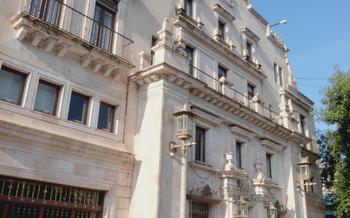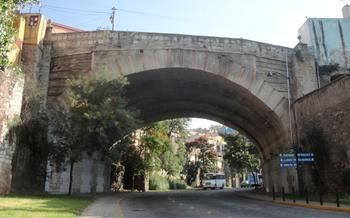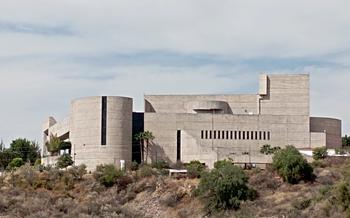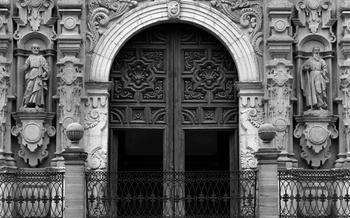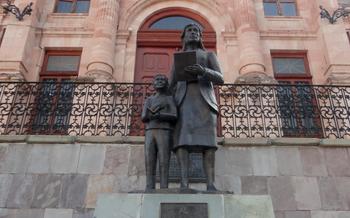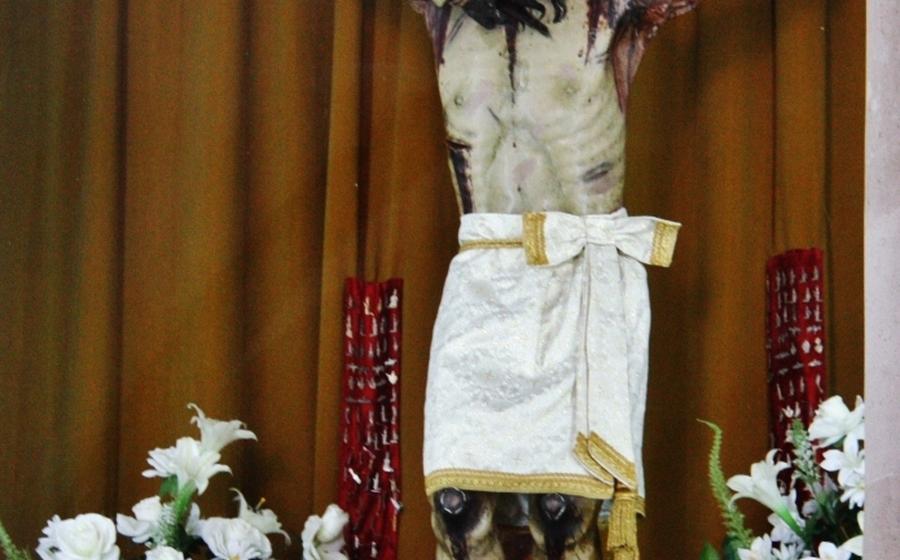
Mummies of Guanajuato Museum (El Museo de las Momias de Guanajuato)
- The Macabre History of Guanajuato's Mummies
- Location and Accessibility:
- Stepping into the Museum's Eerie Atmosphere
- A Glimpse into the Lives of the Deceased
- Mummification Process and Techniques
- Guanajuato's Mining Heritage
- Cultural and Historical Significance: A Window into Guanajuato's Past
- Eerie Encounters and Folklore
- Controversy and Ethical Concerns:
- Tips for a Memorable Visit
- The Guanajuato Mummy Museum in Popular Culture
- Exploring Guanajuato's Vibrant City
- Unforgettable Moments and Lasting Impressions
- Insider Tip for a Unique Perspective
The Macabre History of Guanajuato's Mummies
Guanajuato's mummies are a testament to the city's rich and often macabre history. The story begins in the 16th century when Guanajuato became a major mining center. Miners flocked to the city in search of silver and gold, but many succumbed to harsh working conditions and diseases.
In the 19th century, a cholera epidemic swept through Guanajuato, killing thousands of people. The city's cemeteries were overwhelmed, and the bodies of the deceased were buried in mass graves. The unique climatic conditions in Guanajuato, characterized by low humidity and constant temperatures, led to the natural mummification of these bodies.
The mummies were discovered in the early 1900s during the expansion of a cemetery. They were initially displayed in a small room in the local cemetery, but their popularity quickly grew, and they were eventually moved to a dedicated museum. Today, the Mummies of Guanajuato Museum is one of the city's most popular tourist attractions, drawing visitors from around the world.
Location and Accessibility:
The Mummies of Guanajuato Museum is situated in the heart of Guanajuato City at 208 Ponciano Aguilar Street, just a short walk from the city's main square, the Jardín de la Unión. Reaching the museum is a breeze, whether you're driving from major cities like Mexico City or Querétaro or opting for public transportation. If you're driving, you can easily find on-street parking or utilize one of the nearby parking garages. Alternatively, you can take a bus or taxi from the central bus station or the airport. The museum's operating hours are from 9 am to 6 pm every day of the week, except for Christmas Day. Ticket prices are affordable, ranging from 70 pesos for adults to 35 pesos for children and students. The museum is also accessible for visitors with disabilities, featuring ramps and elevators throughout the facility.
Stepping into the Museum's Eerie Atmosphere
The Mummies of Guanajuato Museum is housed in a former chapel, adding to its already eerie ambiance. The building's unique architecture, with its vaulted ceilings and arched doorways, creates a sense of solemnity and reverence. The dimly lit hallways and chambers further contribute to the museum's somber atmosphere, casting an ethereal glow upon the mummified remains.
As you wander through the museum's interior, a haunting silence envelops you, broken only by the occasional creak of a floorboard or a hushed whisper from a fellow visitor. The air hangs heavy with a palpable sense of history and mortality. The sheer number of mummified bodies on display can be overwhelming, each one a silent testament to the fragility of life.
The emotional impact of encountering so many mummified remains can be profound. Some visitors may feel a sense of awe and wonder, while others may experience a mix of curiosity and unease. The mummies offer a unique window into the past, allowing us to glimpse the lives and deaths of individuals who lived centuries ago.
A Glimpse into the Lives of the Deceased
Within the Mummies of Guanajuato Museum, each mummified figure holds a unique story, offering a glimpse into the lives of those who once walked the streets of this vibrant city. Among them, visitors can encounter the mummified remains of children, adults, men, and women, each with their own personal history and background.
Through the clothing, artifacts, and belongings displayed alongside the mummies, visitors can piece together the lives of these individuals. Whether it's a delicate piece of jewelry, a worn-out shoe, or a religious object, these items provide clues to the lives they lived, the families they cherished, and the challenges they faced.
The museum's collection also includes a variety of medical records and scientific studies that shed light on the causes of death for many of the mummies. These documents reveal the harsh realities of life in Guanajuato during the 19th century, where diseases such as cholera, smallpox, and tuberculosis were rampant.
By delving into the lives of the deceased, visitors to the Mummies of Guanajuato Museum gain a deeper understanding of the human experience and the fragility of life. These mummified remains serve as a poignant reminder of the past, connecting visitors to the stories of those who came before them.
Mummification Process and Techniques
Guanajuato's unique climate, characterized by low humidity and constant temperatures, played a crucial role in the natural mummification process. The arid environment drew out the moisture from the bodies, preventing decomposition. Additionally, the high altitude and the presence of minerals in the soil further contributed to the preservation of the remains.
To ensure the bodies' longevity, additional preservation methods were employed. The miners would often cover the bodies in lime or salt, which acted as desiccants, further absorbing moisture and inhibiting bacterial growth. In some cases, the bodies were also wrapped in cloth or leather to provide additional protection.
The preparation of the bodies for display involved a delicate and meticulous process. The mummies were carefully cleaned and restored to their original positions. Missing limbs or body parts were reconstructed using wax or other materials. The mummies were then arranged in glass display cases, where they could be viewed by visitors.
The ethical considerations surrounding the display of human remains are complex and ongoing. Some argue that it is disrespectful to display the deceased in such a manner, while others believe that it is a valuable way to preserve and showcase local history. The museum has taken steps to ensure that the mummies are treated with respect and dignity, and that their display is done in a sensitive and educational manner.
Guanajuato's Mining Heritage
Guanajuato's mining heritage is deeply intertwined with the story of its mummies. The city's rise to prominence began in the 16th century when silver was discovered in the surrounding mountains. Mining quickly became the lifeblood of Guanajuato, attracting thousands of miners from across the country and beyond.
The working conditions in the mines were harsh and dangerous. The miners toiled in cramped and poorly ventilated tunnels, often inhaling toxic fumes and risking their lives in cave-ins and other accidents. Many miners succumbed to illnesses such as cholera and tuberculosis, which were rampant in the unsanitary conditions of the mining camps.
The mummies provide a glimpse into the lives of these miners. Many of the mummies are dressed in the clothes they wore while working in the mines, and their bodies bear the scars of their arduous labor. The mummies also shed light on the social and cultural aspects of mining life, such as the strong sense of community among the miners and the role of women in supporting the mining industry.
The mining industry had a profound impact on Guanajuato's cultural identity. The city's wealth and prosperity attracted artists, musicians, and intellectuals, who contributed to the city's vibrant cultural scene. The mining industry also shaped Guanajuato's architecture, with many of the city's most iconic buildings constructed using mining profits.
Today, mining is no longer a major industry in Guanajuato, but the city's mining heritage is still evident in its architecture, its museums, and its people. The Mummies of Guanajuato Museum is a reminder of the city's mining past and the sacrifices made by the miners who built Guanajuato into the vibrant city it is today.
Cultural and Historical Significance: A Window into Guanajuato's Past
The Mummies of Guanajuato Museum is not just a macabre spectacle but a profound cultural and historical treasure. It has been designated a UNESCO World Heritage Site, recognizing its exceptional value to humanity. The mummies serve as tangible links to Guanajuato's rich and complex past, shedding light on the lives, struggles, and triumphs of its people. Through these mummified remains, visitors can gain a deeper understanding of the city's mining heritage, social customs, and the impact of epidemics on its population.
The museum plays a crucial role in preserving and showcasing local history. It is a place where visitors can delve into the stories of the deceased, learn about their backgrounds, and appreciate the artifacts that provide glimpses into their lives. The scientific study of the mummies has yielded significant insights into the causes of death, contributing to our understanding of past diseases and medical practices.
Moreover, the mummies have become cultural icons, deeply embedded in Guanajuato's identity. They are a source of fascination and curiosity, attracting both domestic and international visitors. Their unique allure has turned the museum into a must-see destination, contributing to the city's cultural tourism and preserving its rich heritage for generations to come.
Eerie Encounters and Folklore
The Mummies of Guanajuato Museum is steeped in local legends and folklore, adding to its eerie atmosphere. Stories of spirits and restless souls wandering the halls at night are whispered among locals. Some claim to have witnessed unexplained phenomena, such as flickering lights, disembodied voices, and strange shadows.
The mummies themselves are said to possess supernatural powers. Some believe they can grant wishes or bring good luck to those who touch them. Others claim to have experienced strange sensations or even visions after encountering the mummies.
During the annual Day of the Dead celebrations in Guanajuato, the mummies take center stage. Locals and tourists alike gather at the museum to pay their respects and participate in traditional rituals. Offerings of flowers, candles, and food are placed at the mummies' feet, and prayers are said for their souls.
The mummies of Guanajuato have become deeply entwined with the city's cultural identity. They serve as a reminder of the city's rich history and the enduring fascination with the macabre. Whether you believe in the supernatural or not, there is no denying the eerie allure of the Mummies of Guanajuato Museum.
Controversy and Ethical Concerns:
The display of human remains at the Mummies of Guanajuato Museum has sparked ongoing ethical debates. Some argue that it is disrespectful to the deceased and their families to exhibit their bodies in such a manner. Questions have been raised about whether the consent of the individuals or their descendants was obtained before their remains were put on display.
Critics also point out that the museum's focus on the macabre and sensational may overshadow the historical and cultural significance of the mummies. They argue that the museum should strive to strike a balance between preserving history and respecting the dignity of the dead.
In response to these concerns, the museum has implemented measures to address ethical considerations. Visitors are required to show respect for the remains and refrain from taking photographs or videos without permission. The museum has also collaborated with anthropologists and historians to ensure that the exhibits are presented in a respectful and informative manner.
The debate over the ethics of displaying human remains is likely to continue, as it raises complex questions about the balance between historical preservation and respect for the dead. The Mummies of Guanajuato Museum serves as a reminder that even in death, human remains have the power to evoke strong emotions and challenge our ethical sensibilities.
Tips for a Memorable Visit
To make the most of your visit to the Mummies of Guanajuato Museum, consider arriving early in the morning or late in the afternoon to avoid the crowds. Guided tours are available in English and Spanish, providing insights into the history and significance of the mummies. Audio guides are also available for self-guided tours.
Photography is allowed within the museum, but using flash is prohibited to preserve the integrity of the exhibits. Visitors are encouraged to be respectful and maintain silence while exploring the museum, as a sign of respect for the deceased.
After your visit to the museum, consider exploring other attractions in Guanajuato. The city is home to numerous historical landmarks, museums, and art galleries. The nearby Jardin de la Union, a beautiful central plaza, offers a lively atmosphere with cafes, restaurants, and street performers. Take advantage of Guanajuato's vibrant culinary scene by sampling local dishes such as enchiladas mineras and mole poblano.
The Guanajuato Mummy Museum in Popular Culture
The Mummies of Guanajuato Museum has captured the attention of filmmakers, television producers, and documentarians worldwide, becoming a popular subject in the world of entertainment. The eerie atmosphere and fascinating stories surrounding the mummies have provided a unique backdrop for various productions.
In 1970, the Mexican horror film "La Muerte Viviente" (The Living Dead) featured the Guanajuato mummies as central characters, adding to their mystique and popularity. The film's depiction of the mummies as vengeful spirits seeking retribution captivated audiences and solidified their place in Mexican pop culture.
More recently, the museum was featured in an episode of the popular travel show "Anthony Bourdain: Parts Unknown." In the episode, Bourdain explored the history of the mummies and their significance to Guanajuato's culture. His visit brought international attention to the museum and helped to raise awareness of its unique collection.
The museum's mummies have also been the subject of documentaries and television specials, including "Mummies of Guanajuato: A Mexican Mystery" and "Mexico's Living Dead." These productions have delved into the scientific and historical aspects of the mummies, providing viewers with a deeper understanding of their origins and preservation.
The Guanajuato Mummy Museum's presence in popular culture has undoubtedly contributed to its status as a must-visit destination for travelers worldwide. The museum's captivating exhibits and unique atmosphere continue to inspire awe and wonder, ensuring its place as a beloved and unforgettable attraction in the heart of Guanajuato.
Exploring Guanajuato's Vibrant City
Beyond the Mummies of Guanajuato Museum, the city itself is a captivating blend of history, culture, and charm. Designated as a UNESCO World Heritage Site, Guanajuato boasts a rich tapestry of architectural wonders, vibrant traditions, and culinary delights. Strolling through its cobblestone streets, visitors are greeted by colorful facades, ornate churches, and enchanting plazas, each telling a tale of the city's storied past.
Must-see landmarks include the majestic Teatro Juárez, a masterpiece of neoclassical architecture, and the iconic Monumento al Pípila, a tribute to a local hero who played a crucial role in the Mexican War of Independence. The city's museums, such as the Museo Iconográfico del Quijote and the Museo Regional de Guanajuato, offer a glimpse into Guanajuato's artistic and historical heritage.
Guanajuato's culinary scene is equally enticing, with traditional dishes like enchiladas mineras and mole poblano tantalizing taste buds. Visitors can savor these culinary delights at local restaurants, often accompanied by the soulful melodies of mariachi bands.
As night falls, the city transforms into a vibrant hub of entertainment. Lively bars, nightclubs, and traditional cantinas beckon visitors to experience Guanajuato's infectious energy. The city's plazas come alive with music, dance, and laughter, creating a palpable sense of alegría that lingers long after the sun sets.
Unforgettable Moments and Lasting Impressions
Stepping into the Mummies of Guanajuato Museum is a truly unforgettable experience. The emotional impact of encountering so many mummified remains is profound. Each body tells a story, and as you gaze upon their preserved forms, you can't help but feel a sense of awe and wonder. The museum provides a glimpse into the lives of these individuals, their struggles, and their triumphs. It's a reminder of our own mortality and the fragility of life.
Personally, I was particularly moved by the story of a young woman named Santa Paula. Her mummified body is one of the most well-preserved in the museum, and her tragic tale left a lasting impression on me. According to legend, Santa Paula was a beautiful young woman who died of a broken heart after her lover left her. Her body was exhumed a few years later, and to everyone's astonishment, it was found to be perfectly preserved.
Visiting the Mummies of Guanajuato Museum is an experience that will stay with you long after you leave. It's a journey through history, culture, and the human condition. It's a place where you can confront your own mortality and gain a deeper appreciation for the preciousness of life.
Insider Tip for a Unique Perspective
If you seek a truly unique and immersive experience, time your visit to coincide with Guanajuato's annual Mummy Festival held in late October or early November. This vibrant celebration honors the city's mummies and their enduring legacy. During the festival, the museum extends its hours and offers special events, guided tours, and exhibitions. You'll have the chance to witness traditional dances, music, and performances inspired by the mummies' stories. It's a fantastic opportunity to delve deeper into Guanajuato's fascinating history and culture while experiencing the city's festive spirit.




